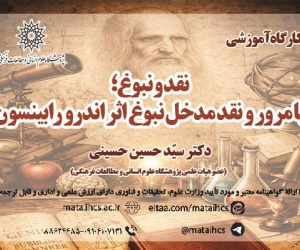تحلیل گفتمان خطبه توحیدیه امام رضا (ع) (مقاله علمی وزارت علوم)
درجه علمی: نشریه علمی (وزارت علوم)
آرشیو
چکیده
این تحقیق درصدد است خطبه توحیدیه امام رضا (ع) را به صورت تحلیلی توصیفی، مبتنی بر رویکرد روش عملیاتی تحلیل گفتمان (پدام) در پنج فضای گفتمانی «فضای نظری ساختاری»، «فضای معنایی ارزشی»، «فضای ارتباطی هویتی»، «فضای گفتمانی»، و «فضای فراگفتمانی» مورد تحلیل قرار دهد. هدف این پژهش، رمزگشایی سبک بیانی امام در ارائه مفاهیم عمیق فلسفی توحید و کشف لایه های زیرین معنایی خطبه و ناگفته های غایب آن، سپس استخراج گفتمان حاکم بر آن و فرایندهای مؤثر بر شکل گیری آن است. نتیجه پژوهش حاکی است که پیوستگی و انسجام عبارت ها، گزینش واژگان مأنوس و رایج، دقت در نظم و چینش آن ها و موسیقی برآمده از واژگان و عبارت های آهنگین و سجع و قافیه، موجب شده، سبک بیان خطبه شیواترین و رساترین سبک برای ادای معانی عمیق فلسفی شود و متنی را به وجود آورد که سرتاسر عبارت های آن، واحد منسجمی را تشکیل می دهد که غیرقابل تفکیک هستند. در تحلیل این خطبه همچنین شاهد نمونه هایی از بینامتنیت ها هستیم، امام رضا (ع) آیات قرآن را محور اصلی بحث خود قرار می دهند، برخی از فرازهای خطبه تداعی کننده تضمین های قرآنی و برخی تداعی کننده فرمایش های حضرت امام علی (ع) هستند که در کشف فضای گفتمانی خطبه تاثیرگذار است. دال های اساسی، فراگفتمانی و نقشه معنایی به دست آمده از تحلیل این خطبه نشان دهنده عمق معنایی آن درباره شناخت خداوند متعال است که به طور اختصار شامل موارد ذیل است: 1. ایمان کامل به خداوند، 2. تفاوت نداشتن ذات با صفات خدا، 3. خدا معلول نیست.Discourse Analysis of Imam Riḍā's (as) Monotheistic Sermon
This research aims to examine and analyze the monotheistic sermon of Imam Riḍā (as) with an analytical-descriptive form approach, based on the operational method of discourse analysis (Pedam) in five discourse spaces: "theoretical-structural space", "semantic-value space", " communication-identity", "discourse space", and "meta-discourse space"; and then extract and draw the basic signs and finally the semantic map of the said sermon using this method. In order to achieve this goal, the research has tried to decipher Imam Riḍā's (as) expression style in the monotheism sermon, and explain the array of deep philosophical concepts of monotheism, and the discovery of the underlying semantic layers of the sermon and its unspoken explanations, and then extract the discourse that governs it and the processes affecting its. The most important results obtained from the analysis of the monotheistic sermon show the continuity, coherence and harmony of the phrases, the selection and use of familiar and common words that are understandable for the society, the accuracy in the order and arrangement of the words and concepts mentioned, and the musical rhythm arising from the melodious words and phrases and their rhyme, so that all these have caused the style of delivering the sermon to be one of the most eloquent and expressive styles for expressing deep philosophical meanings, and created a text that all its phrases form a coherent map of meaning that is inseparable. In the analysis of this sermon, we also see examples of intertextuality; Imam Riḍā (as) makes the verses of the Qur'an the main focus of his discussion; some parts of the sermon evoke Quranic concepts, and some of them evoke the sayings of Imam Ali (as), which are influential in discovering the discourse space of the sermon. The basic signifiers, meta-discourse and semantic map obtained from the analysis of this sermon indicate its semantic depth about knowing Almighty Allah, which briefly includes the following: 1. complete faith in Allah; 2. the lack of difference between essence and Allah's attributes; 3-Allah is not impressionable.









